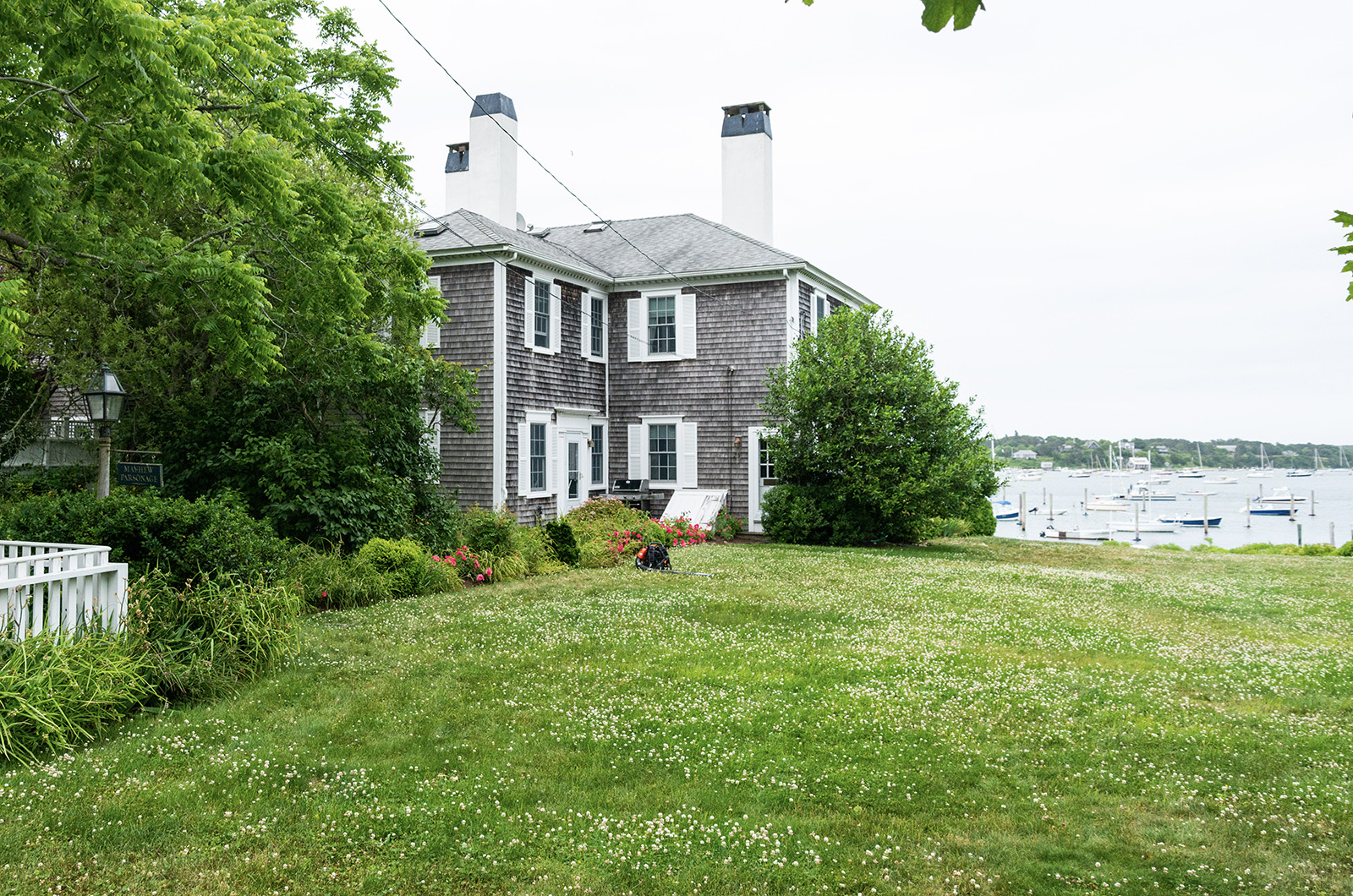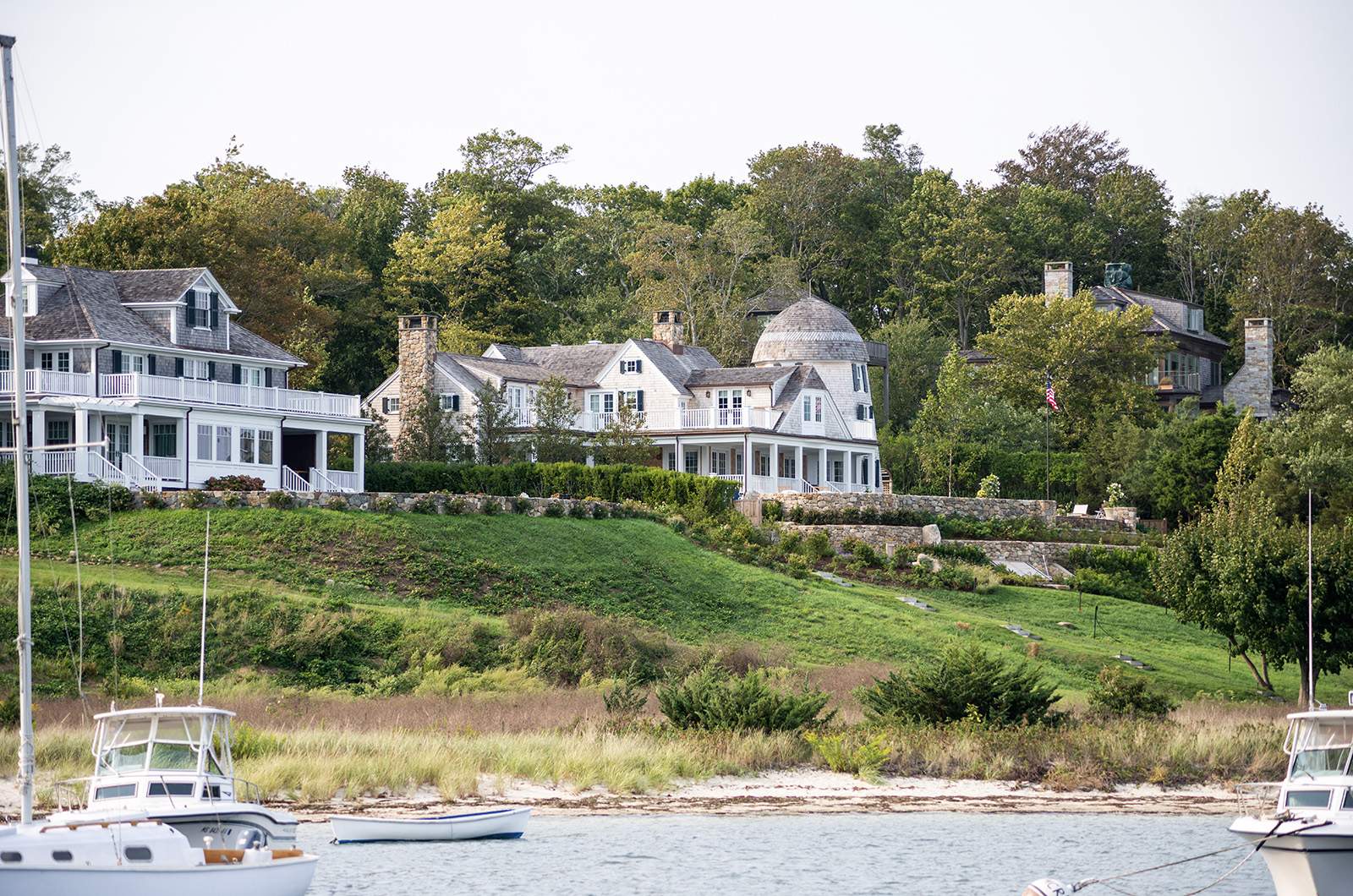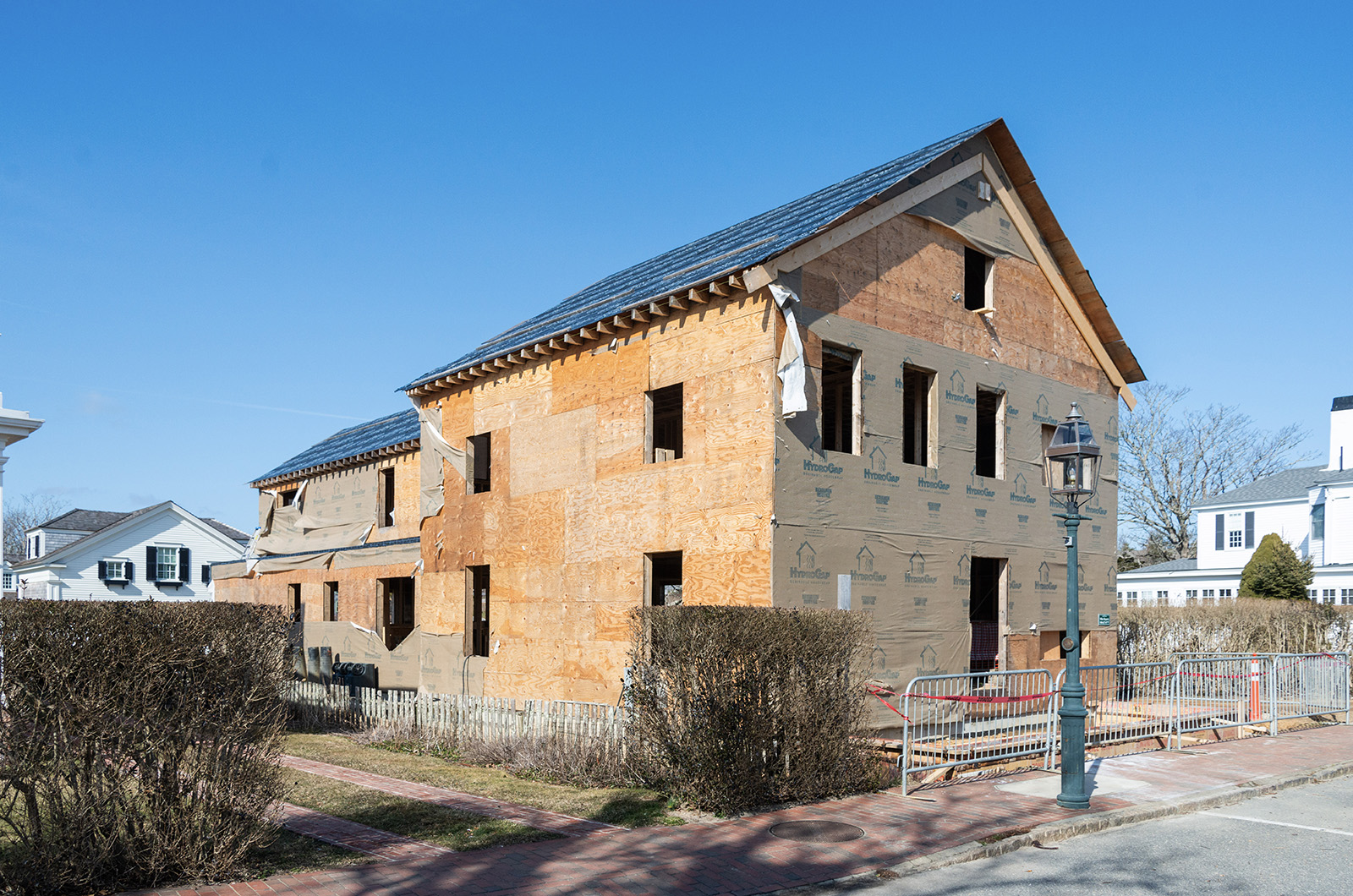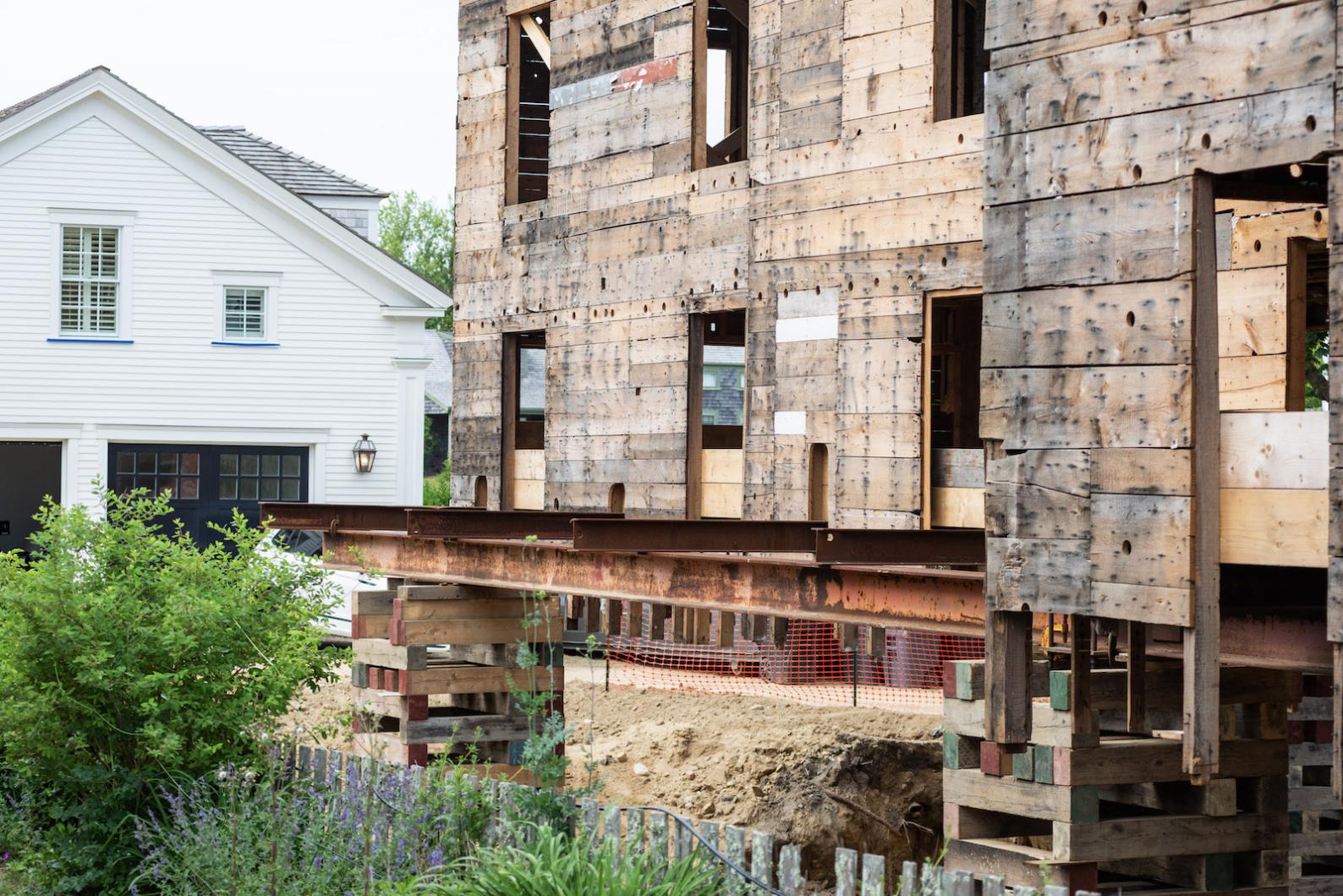Across the Island but particularly in the down-Island towns, changing tastes and demands from owners of historic homes are increasingly butting up against rules designed to preserve the character of the Island.
One factor is the rise of cheaper, synthetic materials used in building, but architects and real estate agents also note that today’s homeowners want bigger, open-plan spaces, luxury amenities like swimming pools, and newer, energy-saving appliances.
Town historic district commissions and the Martha’s Vineyard Commission are tasked with negotiating with homeowners who seek to alter their historic properties, to mixed results. In previous stories, the Gazette has outlined the challenges these boards face to reach an agreement.

But what happens when homeowners defy these orders? Recently, several homeowners have attempted to circumvent historic district rules, drawing ire from neighbors, who worry about the “Disney-ification” of Vineyard architecture, in which rebuilds and major renovations leave only a tourist-friendly simulacrum of the century-old structure that stood before it.
“I think people can tell the difference, I really do,” longtime Edgartown historic district homeowner Jane Bradbury said. “There’s something in people’s bones that tell them, ‘This isn’t right.’”
As infractions continue and building applications rise, local and regional boards are looking at what tools, if any, are available to hold bad actors accountable once the permitting goes through.
For its part, the MVC does not have any official enforcement arm. In extreme cases like that of Vineyard Haven's Mill House, which was abruptly demolished against orders in 2019, the MVC issued the builders a $100,000 fine to go towards historic preservation – the first and only penalty of its kind on the Island.
Local historic districts on the other hand can work directly with their town’s building department to ensure builders and architects stay in compliance – a function that Edgartown historic district commission chair Julia Tarka said has become more important in recent years.
In 2016, an unpermitted demolition on School street in Edgartown prompted the historic district commission to begin working more directly with building inspector Reade Milne, Ms. Tarka said.
“She’s really our eyes and ears on the ground,” she said.
In addition to regular inspections, Ms. Milne said she and her assistant take frequent informal walks around downtown Edgartown to see how a project is progressing. Often, those between-check-up walks are what tip her off that a renovation has gone too far.
“It helps that the district is not too big, and we know the area really well,” Ms. Milne said. “We know what to look for when something’s off.”
That approach becomes complicated, however, when development booms and departments become overwhelmed. While construction is technically down from its pandemic peak, 2022 was still the second busiest year in terms of building permits in town history, and 2023 was not far behind, she said.
The flurry of permit requests makes it all the more difficult to catch mistakes before they become larger issues, she said. Last August, Ms. Milne issued a cease and desist to a project at 114 North Water street after workers began demolishing the roof without prior approval. The demolition was already several weeks underway; the prospective house was listed for sale for $20 million. The listing has since been taken down.

It was not the first time an incident like this has happened, Ms. Tarka said, but at the time, Ms. Milne said it was one of the most egregious instances she’d seen.
“People have made changes after they get their certificate [of approval],” Ms. Tarka said. “Sometimes they know to come back, sometimes they don’t.”
The North Water street project returned to the historic district commission’s review this past November, but not before the project’s general contractor Chris Miller bowed out from the project completely. In a letter sent to the commission before the hearing, Mr. Miller notified the board his professional work on the project was done and that contractor Joe Delory would be taking over from that point forward.
In January, the historic district commission met again with Mr. Delory to find an agreeable path forward for the new project, eventually approving a new plan out of three potential options.
Ms. Milne attends all commission meetings to ensure that all certificates of appropriateness comply with building codes. There is sometimes a discrepancy, however, between what a contractor says is needed from the building code and what is actually necessary, she said. For example, under state building code, existing buildings are held to a very different standard than new construction.
“Oftentimes, contractors will say they need to do something to bring it up to code, and that sounds like a good thing,” Ms. Milne said. “But in terms of what is necessary to bring an existing building up to code, there’s actually very little [needed],” Ms. Milne said. “There’s a lot of leeway.”
In some cases, building departments can revoke a builder’s license for repeat infractions, but Ms. Milne said no penalty of that kind has occurred in her tenure. Peter Rosbeck, the builder behind the Mill House demolition, currently serves as co-chair of the Edgartown historic district commission.
Current owners of historic homes can play a role in preserving them for future generations too. Some historic preservationists have highlighted deed restrictions as one such tool, allowing homeowners to limit the changes to their homes long after they’ve sold. In Edgartown, a view easement deed restriction on the former Mayhew Parsonage played a part in a recent controversy over a proposed renovation next door at 81 South Water street.

Solutions like these, however, require homeowners to have the foresight and will to restrict what might happen to their homes once they sell. When Edgartown homeowner John Brittain first pushed waterfront residents to consider adopting a view easement deed restriction, he canvassed door-to-door on Edgartown’s historic North and South Water streets. Only two homes agreed to preserve their views, he said.
When architects and builders are paid based on a percentage of home value, they have a vested interest to build bigger and newer, Mr. Brittain added.
Architect Patrick Ahearn has spent more than 30 years of his career updating and restoring the Vineyard’s historic Greek revival homes. His projects include many of the homes in Edgartown’s historic district, including the controversial 81 South Water street renovation. In the past, Mr. Ahearn said he has worked with clients to strike a balance between contemporary amenities Island residents have come to expect and architecture that honors the Vineyard’s historic character.
In some cases, that means opening up a house’s interior floor plan while preserving its original façade, he said, or adding a finished basement to keep the house’s existing grade. In Edgartown in particular, Mr. Ahearn said he has noticed a trend of more homeowners scaling down as formal living and dining rooms go out of fashion.
“You want to start with context, what the neighborhood’s about, what the street’s about,” he said. “Paying attention to your surroundings is very important.”
Technology, he said, has also come a long way to help bring older buildings seamlessly into the 21st century. Energy-saving heat pumps have become more effective and less conspicuous, and synthetic materials are now more durable and aesthetically pleasing, allowing architects to both meet energy codes and preserve the look of a historic façade in a more cost-effective manner.
Out of the 250 Edgartown homes Mr. Ahearn has built or renovated, he estimated about 60 per cent were designated historic houses, with the rest being newer builds. His process, he said, is to create a historical narrative for each project regardless of whether it has known historical significance.
“We’re always looking at the architecture of the community and how you could do [a project] in a quiet way where you can’t tell what’s new and what’s old,” he said.
Even still, historic districts have found that sometimes it takes a village to preserve a house. In Oak Bluffs, historic district commission member Shelley Christiansen said it’s often up to the commission members themselves – and vigilant neighbors – to spot when something isn’t quite right. For that reason, she said it’s particularly important that she and her fellow commission members make airtight judgments ahead of time – even if they aren’t the most popular.
“You know the phrase, ‘Better to ask forgiveness than permission,’?” Ms. Christiansen said. “We work hard to make sure that’s not our reputation.”
Tisbury historic district commission chair and longtime realtor Judy Federowicz said historic preservation is often misunderstood and undersung. She said incidents like the Mill House, although tragic, can help the general public better understand the importance of historic preservation and why local and regional boards make the decisions they do – before it’s too late.
“We’ve always been the ones to sound the alarm,” she said. “We used to be thought of as a quaint little committee of little old ladies, the ‘hysterical society’ or whatever, but it’s important, what we do...Our job is to maintain and preserve something that once you lose it, you can’t get it back.”
This is the fourth and final article in a series on the Vineyard's historic homes. To read the rest of a series visit the State of Historic Preservation page.







Comments (6)
Comments
Comment policy »